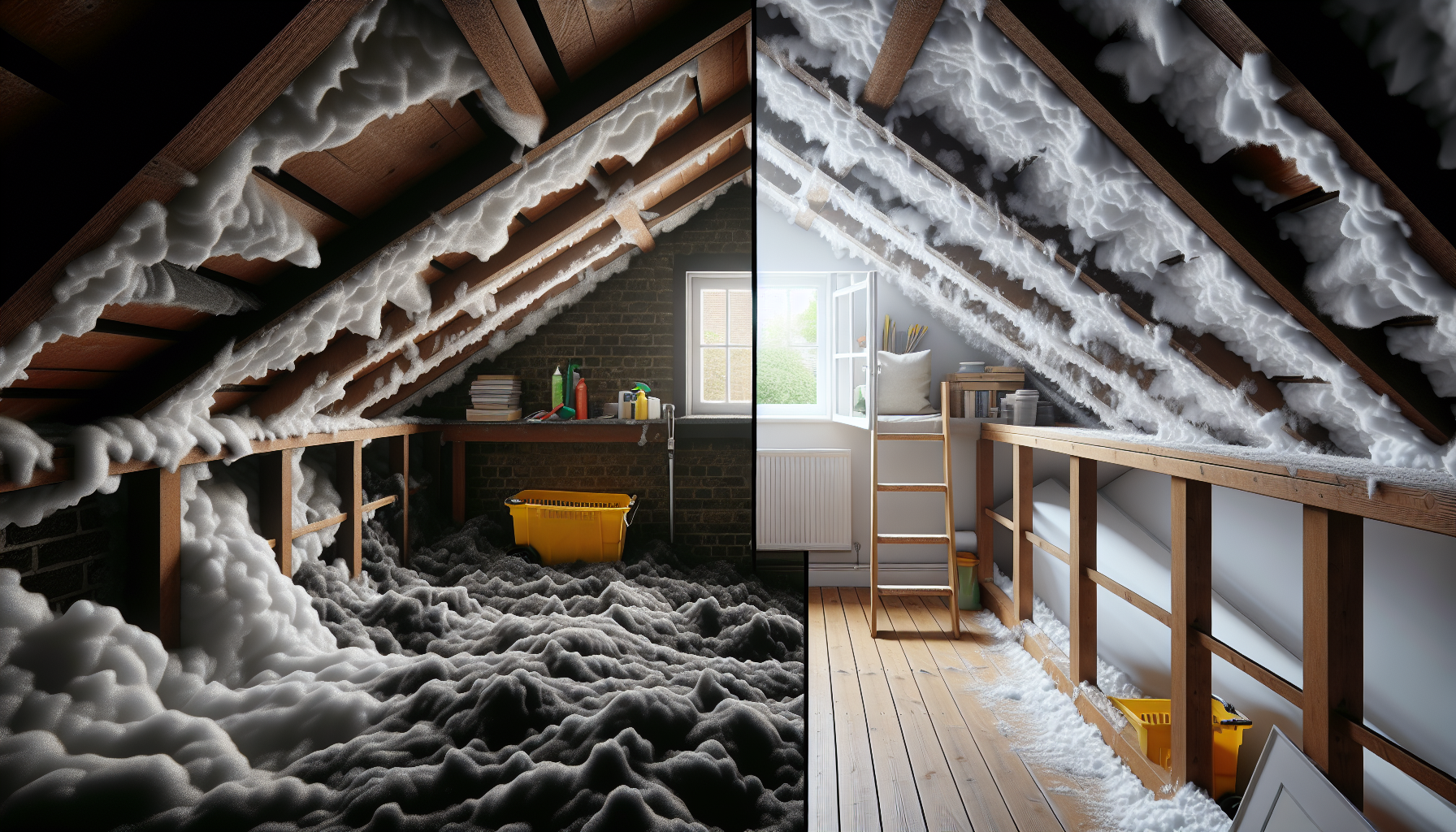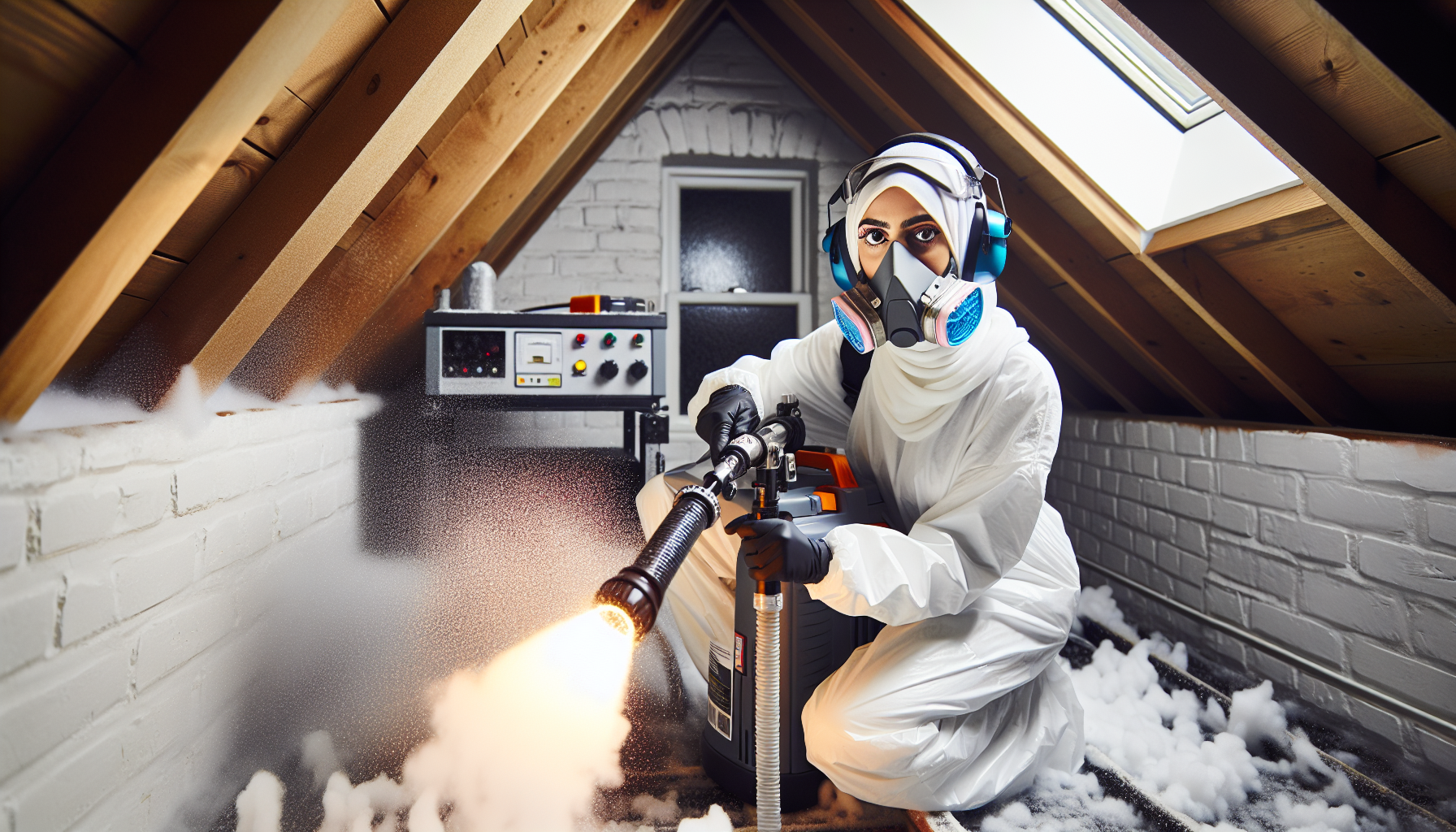Introduction: The Growing Concern for UK Homeowners with Closed-Cell Foam
Thousands of UK homeowners who once believed they'd made a smart investment in closed-cell spray foam insulation are now facing an alarming reality: their 'energy-efficient' solution has become a costly liability. What was marketed as a cutting-edge insulation technology has evolved into one of the most significant property challenges affecting the British housing market today.
The Problem Plaguing UK Properties
Closed-cell spray foam insulation, whilst effective at reducing heat loss, is now causing widespread issues that extend far beyond energy efficiency concerns. Homeowners across England, Scotland, Wales, and Northern Ireland are discovering that this once-popular insulation method is creating serious complications:
- Mortgage rejections from major UK lenders who now view spray foam as a high-risk feature
- Property devaluation with some homes becoming virtually unsellable
- Structural damage to roof timbers, rafters, and wooden frameworks
- Ventilation problems leading to damp, condensation, and potential health hazards
- Insurance complications with some providers refusing to cover spray foam-related claims
The Royal Institution of Chartered Surveyors (RICS) has raised significant concerns about closed-cell foam applications, particularly when installed incorrectly or without proper consideration for building physics. UK mortgage lenders including major high street banks are increasingly flagging properties with spray foam insulation during valuation surveys, often requiring expensive removal before proceeding with loans.
Why Professional Removal is Critical
The removal of closed-cell spray foam isn't a DIY project. This dense, adhesive material bonds aggressively to roof structures, and improper removal can cause irreversible damage to timber frameworks that may have been weakened by years of trapped moisture and restricted airflow.
Your Complete Guide to Resolution
This comprehensive guide addresses the growing need for professional closed-cell spray foam removal services across the UK. We'll explore the specific problems caused by this insulation type, explain why specialist removal companies are essential for safe extraction, and provide practical advice on selecting reputable UK spray foam removal contractors.
Whether you're facing mortgage difficulties For more information, see our detailed FAQ about mortgage impact., planning to sell, or dealing with structural concerns, understanding your options for closed-cell foam insulation removal is crucial for protecting your property investment and ensuring your home's long-term integrity.
Understanding Closed-Cell Spray Foam: What Is It and Why Is It Problematic?
Closed-cell spray foam insulation has become increasingly prevalent in UK homes and commercial properties over the past two decades. This type of insulation consists of a dense, rigid foam that expands and hardens when applied, creating a continuous barrier with excellent thermal properties. Unlike open-cell foam, closed-cell variants have a much denser structure with individual cells that remain sealed, preventing air and moisture penetration.
Properties and Characteristics
Closed-cell spray foam offers several advantageous properties that initially made it attractive to property developers and homeowners:
- High R-value - Typically ranging from R-6 to R-7 per inch, providing superior thermal resistance
- Moisture barrier - Acts as both insulation and vapour barrier due to its impermeable structure
- Structural strength - Adds rigidity to walls and roofing structures
- Air sealing - Creates an airtight seal that eliminates thermal bridging
- Longevity - Designed to last the lifetime of the building without settling or degrading
Why Closed-Cell Spray Foam Becomes Problematic
Despite these benefits, closed-cell spray foam has created significant challenges for UK property owners, particularly regarding mortgage lending and insurance coverage. The primary concern centres around the material's permanence and potential impact on structural timber.
Major UK lenders, including Nationwide, Halifax, and Santander, have implemented restrictive lending policies for properties containing spray foam insulation. This reluctance stems from several key issues:
Structural Concerns:
- Difficulty in inspecting timber structures once foam is applied
- Potential moisture trapping if not properly installed
- Risk of timber rot going undetected beneath the foam layer
- Challenges in maintaining adequate ventilation in roof spaces
Professional Assessment Difficulties:
The dense, adhered nature of closed-cell foam makes it extremely challenging for surveyors and structural engineers to assess the condition of underlying timber work. This limitation has led to increased insurance claims and mortgage lending restrictions across the UK property market.
Removal Complexity:
When problems arise or mortgage requirements demand foam removal, property owners face substantial costs. Specialist spray foam insulation removal companies in the UK typically charge between £15-£40 per square metre, depending on the complexity and location of the installation.
The combination of these factors has created a situation where many UK properties with closed-cell spray foam insulation face reduced marketability, making professional removal services increasingly essential for maintaining property value and securing mortgage approval.
The Financial Fallout: Mortgages, Equity, and Property Value
The presence of closed cell spray foam insulation in your property can trigger a cascade of financial consequences that extend far beyond the initial installation costs. Understanding these implications is crucial for UK homeowners facing the daunting prospect of removal.
Mortgage and Remortgage Challenges
Lenders are increasingly cautious about properties containing spray foam insulation, particularly when applied to roof spaces. Many major UK mortgage providers now require specialist surveys before approving loans on affected properties. This scrutiny can lead to:
- Mortgage refusals or demands for removal before completion
- Higher interest rates due to perceived risk
- Reduced lending amounts as lenders factor in removal costs
- Extended completion times whilst remedial work is undertaken
The Royal Institution of Chartered Surveyors (RICS) guidance has heightened awareness among mortgage lenders, making it essential to address spray foam issues proactively when considering property transactions.
Property Valuation Impact
Independent valuations consistently show that properties with problematic spray foam installations suffer significant depreciation. UK property experts report value reductions ranging from £10,000 to £50,000 depending on the property size and extent of the installation.
Key valuation factors include:
- Structural concerns about roof timber and ventilation
- Future maintenance liabilities that buyers must inherit
- Insurance complications that may affect long-term ownership costs
- Market perception of spray foam as a problematic material
Long-term Equity Implications
The financial impact extends beyond immediate sale difficulties. Homeowners face ongoing equity erosion as the property market increasingly recognises spray foam as a liability rather than an asset. This creates a compound effect where:
- Refinancing becomes problematic as equity positions weaken
- Home improvement investments yield diminished returns
- Retirement planning may be affected for those relying on property wealth
Engaging reputable closed cell spray foam insulation removal UK companies early can help mitigate these financial risks. Professional removal services typically cost between £15,000 and £35,000 for an average UK home, but this investment often proves essential for preserving property value and ensuring mortgage eligibility.
The financial mathematics are stark: whilst removal costs are substantial, the alternative—accepting diminished property value and restricted mortgage options—often proves far more expensive in the long term.
The Perils of DIY Removal: Why You Must Hire a Professional
While the prospect of removing closed cell spray foam insulation yourself might seem like a cost-effective solution, attempting DIY removal can lead to serious complications that far outweigh any initial savings. The complex nature of this material demands specialist expertise that only professional closed cell spray foam insulation removal UK companies can provide.
Health and Safety Hazards
Closed cell spray foam contains potentially harmful chemicals, including isocyanates, which can cause severe respiratory issues, skin irritation, and long-term health problems For more information, see our detailed FAQ about health and safety. when disturbed during removal. Without proper protective equipment and ventilation systems, homeowners risk exposure to toxic fumes and airborne particles. Professional removal specialists use:
- Industrial-grade respiratory protection
- Negative air pressure systems to contain contaminants
- Hazmat suits and protective gear
- Proper waste disposal protocols in compliance with UK regulations
Structural Damage Risks
Closed cell spray foam forms an incredibly strong bond with building materials, often becoming structurally integral to the substrate. Amateur removal attempts frequently result in:
- Damage to timber joists, rafters, and structural elements
- Compromised building envelope integrity
- Unintentional removal of essential vapour barriers
- Costly repairs that exceed professional removal fees
The adhesive properties of this insulation mean that improper removal techniques can literally tear chunks from wooden beams or masonry, potentially compromising your property's structural integrity.
Legal and Insurance Complications
UK building regulations and insurance policies often stipulate specific requirements for insulation removal, particularly when dealing with materials that may contain hazardous substances. DIY removal can void insurance coverage and create compliance issues with local authorities. Professional spray foam removal companies ensure:
- Full compliance with Health and Safety Executive (HSE) guidelines
- Proper documentation for insurance claims
- Certified waste disposal through licensed facilities
- Building control notification where required
The False Economy of DIY
While hiring specialist closed cell spray foam insulation removal UK companies requires an upfront investment, the potential costs of DIY mishaps can be astronomical. Emergency structural repairs, medical treatment for chemical exposure, and insurance claim rejections can easily cost tens of thousands of pounds.
Professional removal companies possess the specialised tools, knowledge, and experience to complete the job safely and efficiently, protecting both your health and your property's value whilst ensuring full regulatory compliance.
The Professional Closed-Cell Foam Removal Method
When facing closed-cell spray foam removal, engaging professional UK companies is essential for safe and effective results. These specialists employ systematic approaches that ensure complete removal whilst protecting your property's structural integrity.
Initial Assessment and Planning
Professional closed-cell foam removal begins with a comprehensive structural assessment. Certified technicians evaluate the foam's adhesion patterns, underlying surface conditions, and potential complications. This critical first step allows UK removal specialists to develop tailored strategies that minimise damage to joists, rafters, and other structural elements.
During this phase, professionals also identify any asbestos-containing materials or other hazardous substances that may be present, ensuring compliance with current UK health and safety regulations.
Mechanical Removal Techniques
The primary method employed by UK spray foam removal companies involves controlled mechanical removal using specialised equipment:
- Oscillating tools for precise cutting and scoring
- Pneumatic scrapers for bulk foam removal
- Wire brushes and abrasive pads for surface finishing
- Industrial vacuum systems for debris collection
Professional teams work systematically, removing foam in manageable sections whilst preserving timber integrity. This methodical approach prevents the aggressive gouging that often occurs with DIY attempts.
Chemical Softening Applications
Where mechanical methods alone prove insufficient, certified professionals may employ approved chemical softening agents. These specialised solutions, used in accordance with UK environmental regulations, help break down the foam's cellular structure, making removal significantly easier.
Professional application ensures:
- Proper ventilation during chemical use
- Surface protection for surrounding materials
- Safe disposal of chemical residues
- Minimal environmental impact
Quality Assurance and Surface Restoration
Following removal, professional UK companies conduct thorough quality inspections to ensure complete foam elimination. Any remaining residue is carefully addressed using appropriate techniques for the specific substrate material.
The final stage involves surface preparation for future treatments, which may include:
- Timber conditioning and treatment
- Surface smoothing and cleaning
- Moisture content assessment
- Recommendations for replacement insulation
Professional closed-cell foam removal typically costs between £15-30 per square metre in the UK, depending on complexity and access requirements. Whilst this represents a significant investment, the expertise provided by certified removal specialists ensures your property's structural elements remain undamaged, ultimately protecting your long-term investment and maintaining your home's integrity.
Finding Reputable Closed Cell Spray Foam Insulation Removal UK Companies
When seeking professional assistance for closed cell spray foam insulation removal, selecting the right contractor is crucial for ensuring safe, effective, and compliant work. The complexity of removing this type of insulation requires specialists with proper training, equipment, and certifications.
Essential Qualifications and Certifications
Reputable closed cell spray foam insulation removal UK companies should possess several key credentials. Look for contractors who hold relevant health and safety certifications, including CSCS (Construction Skills Certification Scheme) cards and specific training in working with spray foam materials. Many established firms will also have certifications from recognised bodies such as CITB (Construction Industry Training Board) or specialist insulation associations.
Additionally, ensure your chosen contractor carries comprehensive public liability insurance, typically covering at least £2 million, and employer's liability insurance. This protection is essential given the potential risks associated with spray foam removal work.
Research and Vetting Process
Begin your search by requesting detailed quotes from multiple closed cell spray foam insulation removal specialists. A thorough quote should include:
- Assessment methodology and timeline
- Removal techniques to be employed
- Safety measures and protective equipment usage
- Waste disposal procedures and associated costs
- Post-removal cleaning and restoration requirements
Verify each company's track record by requesting references from recent projects, particularly those involving similar property types. Check online reviews and ratings on platforms such as Checkatrade, Trustpilot, or local authority approved trader schemes.
Red Flags to Avoid
Be cautious of companies that cannot provide proper insurance documentation or refuse to offer written quotes. Avoid contractors who:
- Quote significantly below market rates without clear justification
- Pressure you into immediate decisions
- Cannot demonstrate relevant experience with closed cell spray foam
- Lack proper safety protocols or equipment
- Offer cash-only payment terms
Professional Standards and Compliance
Leading spray foam removal companies in the UK should demonstrate comprehensive knowledge of current Building Regulations and Health and Safety Executive (HSE) guidelines. They should also be prepared to work with your local building control department where necessary and provide appropriate documentation for mortgage lenders or insurance companies.
The most reputable firms will conduct thorough site assessments before commencing work, explaining their methodology clearly and addressing any concerns about potential structural implications or health risks associated with the removal process.
Conclusion: Reclaim Your Property's Health and Value
Closed-cell spray foam insulation presents a significant challenge for UK property owners, but it's crucial to understand that this problem is entirely solvable with the right professional approach. Throughout this guide, we've explored the serious implications of faulty or problematic spray foam installations, from mortgage complications to structural damage and health concerns.
Key Takeaways for Property Owners
The evidence is clear: closed-cell spray foam removal is not a DIY endeavour. The risks associated with improper removal techniques include:
- Toxic chemical exposure during the removal process
- Structural damage to roof timbers and building fabric
- Incomplete removal leading to ongoing problems
- Invalid insurance claims due to unprofessional work
Professional removal is the only safe and effective solution. Specialist closed cell spray foam insulation removal UK companies possess the expertise, equipment, and certifications necessary to restore your property safely and comprehensively.
Your Property's Future is Secure
Whilst the presence of problematic spray foam can feel overwhelming, particularly when facing mortgage difficulties or surveyor concerns, take comfort in knowing that thousands of UK properties have been successfully remediated. Professional removal specialists have developed proven methodologies that not only eliminate the foam completely but also restore your property's structural integrity and market value.
The key is acting promptly and choosing the right removal company. Established UK companies specialising in closed-cell spray foam removal understand the unique challenges posed by different foam types and installation methods. They work closely with surveyors, mortgage lenders, and insurance companies to ensure your property meets all necessary standards.
Take Action Today
Don't let spray foam issues continue to compromise your property's health, value, or your family's wellbeing. Professional assessment is the first step towards resolution, and many reputable companies offer comprehensive surveys at no cost or obligation.
Contact our specialist team today for a thorough, no-obligation survey and detailed quote. Our experienced technicians will assess your specific situation, explain all available options, and provide a clear pathway to restoring your property. With our proven track record and commitment to safety, we'll help you reclaim your property's health and value efficiently and professionally.
Remember: every day you delay addressing spray foam issues is another day of potential complications. Take control of your property's future now.
Generated Images




Related Articles
- 7 Smarter Alternatives to Spray Foam in UK Homes— PIR...
- RICS Warns: Mortgage Problems from Spray Foam Soar in 202...
- Spray Foam Removal UK: Fast Insulation Removal & Cost Guide




